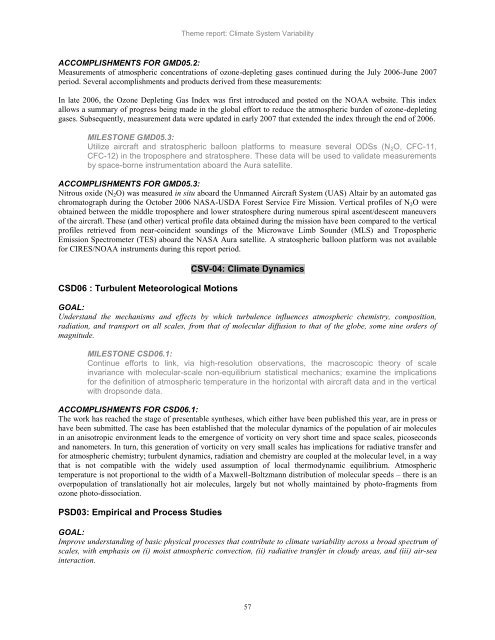Scientific Theme: Advanced Modeling and Observing Systems
Scientific Theme: Advanced Modeling and Observing Systems
Scientific Theme: Advanced Modeling and Observing Systems
Create successful ePaper yourself
Turn your PDF publications into a flip-book with our unique Google optimized e-Paper software.
<strong>Theme</strong> report: Climate System Variability<br />
ACCOMPLISHMENTS FOR GMD05.2:<br />
Measurements of atmospheric concentrations of ozone-depleting gases continued during the July 2006-June 2007<br />
period. Several accomplishments <strong>and</strong> products derived from these measurements:<br />
In late 2006, the Ozone Depleting Gas Index was first introduced <strong>and</strong> posted on the NOAA website. This index<br />
allows a summary of progress being made in the global effort to reduce the atmospheric burden of ozone-depleting<br />
gases. Subsequently, measurement data were updated in early 2007 that extended the index through the end of 2006.<br />
MILESTONE GMD05.3:<br />
Utilize aircraft <strong>and</strong> stratospheric balloon platforms to measure several ODSs (N2O, CFC-11,<br />
CFC-12) in the troposphere <strong>and</strong> stratosphere. These data will be used to validate measurements<br />
by space-borne instrumentation aboard the Aura satellite.<br />
ACCOMPLISHMENTS FOR GMD05.3:<br />
Nitrous oxide (N2O) was measured in situ aboard the Unmanned Aircraft System (UAS) Altair by an automated gas<br />
chromatograph during the October 2006 NASA-USDA Forest Service Fire Mission. Vertical profiles of N2O were<br />
obtained between the middle troposphere <strong>and</strong> lower stratosphere during numerous spiral ascent/descent maneuvers<br />
of the aircraft. These (<strong>and</strong> other) vertical profile data obtained during the mission have been compared to the vertical<br />
profiles retrieved from near-coincident soundings of the Microwave Limb Sounder (MLS) <strong>and</strong> Tropospheric<br />
Emission Spectrometer (TES) aboard the NASA Aura satellite. A stratospheric balloon platform was not available<br />
for CIRES/NOAA instruments during this report period.<br />
CSD06 : Turbulent Meteorological Motions<br />
CSV-04: Climate Dynamics<br />
GOAL:<br />
Underst<strong>and</strong> the mechanisms <strong>and</strong> effects by which turbulence influences atmospheric chemistry, composition,<br />
radiation, <strong>and</strong> transport on all scales, from that of molecular diffusion to that of the globe, some nine orders of<br />
magnitude.<br />
MILESTONE CSD06.1:<br />
Continue efforts to link, via high-resolution observations, the macroscopic theory of scale<br />
invariance with molecular-scale non-equilibrium statistical mechanics; examine the implications<br />
for the definition of atmospheric temperature in the horizontal with aircraft data <strong>and</strong> in the vertical<br />
with dropsonde data.<br />
ACCOMPLISHMENTS FOR CSD06.1:<br />
The work has reached the stage of presentable syntheses, which either have been published this year, are in press or<br />
have been submitted. The case has been established that the molecular dynamics of the population of air molecules<br />
in an anisotropic environment leads to the emergence of vorticity on very short time <strong>and</strong> space scales, picoseconds<br />
<strong>and</strong> nanometers. In turn, this generation of vorticity on very small scales has implications for radiative transfer <strong>and</strong><br />
for atmospheric chemistry; turbulent dynamics, radiation <strong>and</strong> chemistry are coupled at the molecular level, in a way<br />
that is not compatible with the widely used assumption of local thermodynamic equilibrium. Atmospheric<br />
temperature is not proportional to the width of a Maxwell-Boltzmann distribution of molecular speeds – there is an<br />
overpopulation of translationally hot air molecules, largely but not wholly maintained by photo-fragments from<br />
ozone photo-dissociation.<br />
PSD03: Empirical <strong>and</strong> Process Studies<br />
GOAL:<br />
Improve underst<strong>and</strong>ing of basic physical processes that contribute to climate variability across a broad spectrum of<br />
scales, with emphasis on (i) moist atmospheric convection, (ii) radiative transfer in cloudy areas, <strong>and</strong> (iii) air-sea<br />
interaction.<br />
57
















